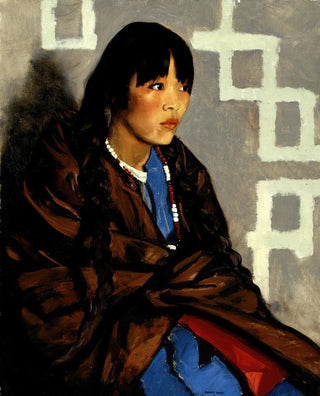Art print | Julianita, Native American girl - Robert Henri


View from behind

Frame (optional)
Julianita, Native American girl - Robert Henri – Captivating introduction
In the fascinating world of art, some works transcend the mere frame to immerse us in a living story. "Julianita, Native American girl" by Robert Henri is one of those pieces that captivate the viewer with their emotional depth and authenticity. Created in the early 20th century, this artwork invites us to explore the inner world of a young girl from Native American culture. Through Henri's gaze, we are invited to an intimate encounter, an exploration of the nuances of the human soul, transcending cultural and temporal barriers.
Style and uniqueness of the work
Robert Henri's style is characterized by a bold approach and mastery of light that brings his subjects to life. In "Julianita, Native American girl," he uses rich and vibrant colors that evoke not only the physical beauty of his model but also the depth of her cultural heritage. Julianita's pose, both serene and contemplative, reveals a quiet strength. Henri manages to capture not only the external appearance of the young girl but also an essence, a soul that resonates with the viewer. The background, although blurred and suggestive, highlights the central figure without ever overpowering it, creating a harmonious balance. This unique and sensitive approach illustrates the ability of art to transcend simple representations and touch the intimate.
The artist and his influence
Robert Henri, an emblematic figure of the Ashcan School movement, played a decisive role in redefining American art in the early 20th century. His commitment to depicting everyday life and subjects often overlooked by artists of his time paved the way for a new understanding of art. Henri did not merely paint portraits; he aimed to capture the very essence of his subjects, highlighting the diversity of the human condition. His influence is still felt today, both in contemporary artistic practices and in art education. By choosing to depict Julianita, he not only highlighted a often marginalized figure but also contributed to broadening the scope of art by incorporating themes of diversity and cultural identity.
A decoration

Matte finish

View from behind

Frame (optional)
Julianita, Native American girl - Robert Henri – Captivating introduction
In the fascinating world of art, some works transcend the mere frame to immerse us in a living story. "Julianita, Native American girl" by Robert Henri is one of those pieces that captivate the viewer with their emotional depth and authenticity. Created in the early 20th century, this artwork invites us to explore the inner world of a young girl from Native American culture. Through Henri's gaze, we are invited to an intimate encounter, an exploration of the nuances of the human soul, transcending cultural and temporal barriers.
Style and uniqueness of the work
Robert Henri's style is characterized by a bold approach and mastery of light that brings his subjects to life. In "Julianita, Native American girl," he uses rich and vibrant colors that evoke not only the physical beauty of his model but also the depth of her cultural heritage. Julianita's pose, both serene and contemplative, reveals a quiet strength. Henri manages to capture not only the external appearance of the young girl but also an essence, a soul that resonates with the viewer. The background, although blurred and suggestive, highlights the central figure without ever overpowering it, creating a harmonious balance. This unique and sensitive approach illustrates the ability of art to transcend simple representations and touch the intimate.
The artist and his influence
Robert Henri, an emblematic figure of the Ashcan School movement, played a decisive role in redefining American art in the early 20th century. His commitment to depicting everyday life and subjects often overlooked by artists of his time paved the way for a new understanding of art. Henri did not merely paint portraits; he aimed to capture the very essence of his subjects, highlighting the diversity of the human condition. His influence is still felt today, both in contemporary artistic practices and in art education. By choosing to depict Julianita, he not only highlighted a often marginalized figure but also contributed to broadening the scope of art by incorporating themes of diversity and cultural identity.
A decoration






